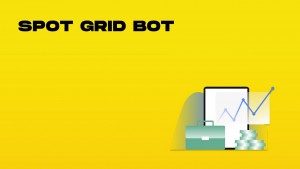What Is a Spot Grid Bot?
A spot grid bot is an automated trading tool that places buy and sell orders at preset price intervals (your “grid”) in the cryptocurrency market. The number of grids, or the number of price levels within the trading grid, affects transaction frequency; a higher number of grids translates to a greater number of orders, thereby increasing trading activity and potential profitability based on price movements. It’s designed to capitalize on natural price volatility by buying low and selling high—over and over again—within a specified price range.
Unlike other trading strategies that require trending markets, grid bots thrive in sideways, range-bound conditions where prices oscillate predictably.
How Spot Grid Bots Work
The mechanics are straightforward but powerful:
-
Set your price range - Define upper and lower price boundaries where you believe the asset will trade
-
Determine grid lines - Decide how many trading levels you want within that range
-
Let the bot execute - The bot places buy orders below current price and sell orders above it
-
Collect profits - Each time the price bounces between your grid lines, the bot locks in small profits
The bot can automatically adjust its parameters, such as grid spacing and price ranges, in response to market conditions, ensuring efficient and effective trading operations.
When price moves up, the bot sells at higher grid lines. When price falls, it buys at lower grid lines. Each completed buy-sell cycle generates profit, regardless of the asset’s overall price trend.
Key Components of a Spot Grid Bot
Price Range
Your upper and lower limit prices define where the bot operates. Choose too wide a range, and your capital gets spread thin. Too narrow, and the price might break out, limiting your profit potential.
Grid Spacing
This determines how far apart your buy and sell orders are placed. Tighter spacing means more grids, leading to more frequent but smaller profits. Wider spacing means fewer but larger profit opportunities.
Investment Amount
The total amount of capital you allocate determines how many grid lines your bot can effectively maintain. More capital generally allows for more grid lines or larger order sizes.
Types of Grid Strategies
Arithmetic Grid
Grid lines are set at equal dollar value intervals (e.g., every $500 for Bitcoin). This works well for relatively stable price ranges.
Geometric Grid
Grid lines follow percentage changes (e.g., every 2% price movement). This adapts better to volatile assets and wider price ranges.
Neutral Grid
Designed for sideways markets with no directional bias.
Bullish/Bearish Grid
Weighted to perform better in upward or downward trending markets, respectively.
Benefits of Using Spot Grid Bots
-
Emotion-free trading - Bots execute your strategy without fear or greed
-
24/7 market participation - Capture opportunities while you sleep
-
Profit in sideways markets - Make money when most traders are bored
-
Dollar-cost averaging effect - Naturally buy more at lower prices
-
Reduced monitoring needs - Set up once and review periodically
-
Capital utilization - Features like 'trailing up/down' and 'AI Plus' dynamically adjust trading parameters to ensure efficient use of invested capital, maximizing profits by adapting to market fluctuations and preventing idle funds
Risks and Limitations
Grid bots aren’t magic money machines. Be aware of these drawbacks:
-
Range breakouts - If price moves beyond your grid, the bot stops being effective
-
Opportunity cost - Capital is locked in the grid during strong directional moves
-
Market shifts - Sudden volatility changes can disrupt your grid spacing effectiveness
-
Technical failures - API issues or exchange downtime can impact performance
-
Tax complications - Numerous small trades can create complex tax reporting
-
Stop loss - A stop loss parameter can help limit losses by selling all base assets at market price if the asset price drops to a pre-defined level, ensuring better control over trading outcomes
Setting Up Your First Grid Bot
Step 1: Choose the Right Market
Look for assets with:
-
Sufficient trading volume (liquidity)
-
Historical tendency to trade in ranges, which can help in leveraging market fluctuations
-
Reasonable volatility (not too flat, not too erratic)
Step 2: Determine Your Grid Parameters
Consider:
-
Recent price history to establish reasonable upper/lower limits
-
How many grid lines make sense for your capital
-
What grid spacing optimizes the expected price movements
-
Understanding your risk tolerance to set parameters that align with your individual risk preferences and market analysis
Step 3: Select a Bot Platform
Popular options include:
-
Exchange-native bots (Binance, KuCoin, etc.)
-
Third-party services (WunderTrading, Bitsgap, Pionex)
-
Open-source solutions for technical users
When selecting a platform, it is crucial to ensure it supports your desired bot strategy, especially if you plan to use grid bots to execute buy and sell orders within specified price ranges.
Step 4: Start Small and Monitor
Begin with a modest allocation until you understand how your bot performs in various market conditions.
Additionally, setting parameters to limit losses, such as a stop loss price, is crucial. This optional parameter automatically stops trading and sells all base assets if the price drops to a predetermined level, thereby preventing further financial loss in a declining market.
Advanced Grid Bot Strategies
Rebalancing Grids
Periodically adjust your grid parameters at predetermined intervals as market conditions evolve to maintain optimal performance.
Multi-Asset Grids
Run multiple grid bots across different cryptocurrencies to diversify and capture more opportunities by allocating your funds effectively.
Leverage Integration
Some platforms allow using leverage with grid bots—amplifying returns but significantly increasing risk.
When the market price exceeds a predefined upper threshold, the bot will cease order placements, which can lead to substantial losses if not properly managed.
Real-World Performance Examples
|
Market Condition |
Grid Performance |
Buy-and-Hold Performance |
|---|---|---|
|
Sideways (±5% range) |
+3-8% monthly |
0% (unchanged) |
|
Mild uptrend (10-15%) |
+5-10% monthly as price rises |
+10-15% total |
|
Strong uptrend (>30%) |
+8-12% monthly |
+30%+ total |
|
Downtrend (-15%) |
+1-5% monthly |
-15% loss |
Note: These figures are illustrative examples and not guaranteed returns. Actual performance varies based on specific parameters, market conditions, and fees.
When Not to Use Grid Bots
Grid bots aren't suitable for every situation:
-
During anticipated major market events (halving, regulatory announcements)
-
In strongly trending markets where a breakout strategy might be better
-
For low-liquidity assets where slippage becomes significant
-
When you lack sufficient capital to create an effective grid
Conclusion: Is a Spot Grid Bot Right for You?
Spot grid bots offer a powerful way to automate crypto trading and potentially generate profits from market volatility—especially in sideways conditions where most traders struggle.
They work best when you:
-
Have reasonable expectations (they won’t make you rich overnight)
-
Understand the market you’re trading
-
Are willing to monitor and adjust your strategy
-
Have the patience to let the grid do its work over time
Whether you’re looking to supplement your trading strategy or reduce the time you spend watching charts, grid bots represent one of the more accessible and practical applications of automation in crypto trading.
Start with a small allocation, learn how these tools perform in different conditions, and you might discover they’re an invaluable addition to your crypto trading toolkit.
























